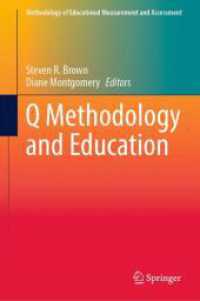- ホーム
- > 洋書
- > 英文書
- > Religion / Ethics
Full Description
The Christian communities of the Middle East distinguish themselves through their unique languages, their ethnic identities and their doctrinal stances. Whereas the history of doctrinal disputes has been a topic of old in Western scholarship, it is only in more recent times that scholars have begun to investigate how the Christian communities of the Nile-to-Oxus region perceived themselves and how they asserted their distinct identities vis-a-vis their neighbours and maintained a sense of communal integrity in response to cultural change and foreign domination. This volume brings together a number of key studies, many specially translated into English for this volume, which deal with this question of Eastern Christian self-definition. In the introduction Barbara Roggema reviews a number of themes which serve as tools to dissect aspects of Christian identity in the Coptic, Syriac, Arabic, Armenian and Georgian communities: labeling of the self and others, the invention of historical and Biblical roots, linguistic pride, the role of doctrine in community formation, and the assertion of superiority vis-a-vis other religions, especially Islam.
Included in the volume is an extensive bibliography on the topic of Eastern Christian self-understanding.
Contents
Contents: Introduction: Bibliography; Part I Diachronic Views of the Formation of eastern Christian Communal Identities: Historiography, hagiography, and the making of the Coptic 'church of the martyrs', Arietta Papaconstantinou; History and identity in the Syrian churches, Michael G. Morony; The Church of Jerusalem and the 'Melkites': the making of an 'Arab Orthodox' Christian identity, Sidney H. Griffith; Myth and reality. Armenian identity in the early Middle Ages, A.E. Redgate. Part II Doctrine and the Negotiation of Identities: Theodoret on the 'school of Antioch'. A network approach, Adam M. Schor; The Church 'of the East'. Ecclesiastical independence and ecclesiastical unity in the 5th century, W. Hage; Nestorius in the 'Nestorian' Church. Shedding light on the self-understanding of the Apostolic Church of the East, Karl Pinggera. Part III Language, Ethnicity and Identity: Did nationalism exist in Byzantine Egypt?, Ewa Wipszycka; The ancient Near East in the late antique Near East. Syriac Christian appropriation of the Biblical past, Adam H. Backer; Identity and self-image in Syria-Palestine in the transition from Byzantine to early Islamic rule, Ahmad Shboul and Alan Walmsley; Identity and universality. Vernacular and written language in the lands of the ancient Christian East, Winfried Boeder; The formative processes of the identity awareness of Christian Armenia and the emergence of an ethnic church, Boghos Levon Zekiyan. Part IV Intercommunal Confrontations and Self-Portrayal: Papyri from the Great Persecution: Roman and Christian perspectives, Annemarie Luijendijk; Conflicts between the non-Latin churches in the Kingdom of Jersualem, Johannes Pahlitzsch and Dorothea Weltecke; Boundary making and self-assertion in a multi-cultural environment. The Christian community of Merw, a metropolis on the Silk Road, in the late Sasanian period, Jurgen Tubach; Index.
-

- 電子書籍
- リフレイム 2






